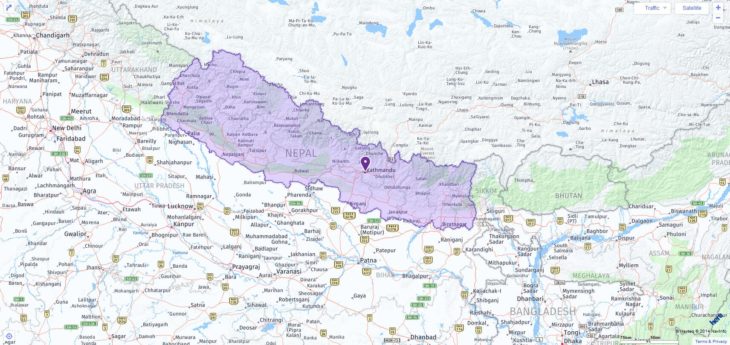Your search found 2 matches. The following is the full list of ACT testing locations in Nepal among which you can pick one to take the exam. Please know that on the test day, test takers can use any 4-function, scientific, or graphing calculator. On the table below, you can also find all test dates through 2019.

2019-2020 ACT Test Dates in Nepal
| Test Date | Registration Deadline |
| February 9, 2019 | January 11, 2019 |
| April 13, 2019 | March 8, 2019 |
| June 8, 2019 | May 3, 2019 |
| July 13, 2019 | June 14, 2019 |
| September 14, 2019 | August 16, 2019 |
| October 26, 2019 | September 20, 2019 |
| December 14, 2019 | November 8, 2019 |
| February 8, 2020 | January 10, 2020 |
| April 4, 2020 | February 28, 2020 |
| June 13, 2020 | May 8, 2020 |
| July 18, 2020 | June 19, 2020 |
ACT Test Centers in Nepal
| City | Center Name | Center Code |
| Kathmandu | ACADEMIC CAREER | 870630 |
| Lalitpur | Rato Bangala School | 871810 |
More about Nepal
Nepal, officially (since May 28, 2008) Nepalese Samghiya Loktantrik Ganatantratmak Nepal, German Democratic Federal Republic of Nepal, previously Nepal Adhirajya, German Kingdom of Nepal, landlocked country in the Himalayas with (2019) 28.6 million residents; The capital is Kathmandu.
Business
Nepal is an agricultural state that is largely characterized by subsistence farming and has a gross national income (GNI) of (2017) US $ 790 per resident to the poorest countries in the world. Around a quarter of the population lives in absolute poverty. The main reasons for the low level of economic development are the scarcity of natural resources, the isolated location, the lack of infrastructure and the political instability. The hitherto largely unused hydropower and tourism have the greatest development potential. Around half of GDP is generated in the service sector, 33% in the agricultural sector and 16% in industry and construction. A third of the state budget is financed through development aid. The money transfers from the Nepalese labor emigrants are also of great importance. The economy suffered a dramatic setback as a result of the earthquake disaster on April 25 and May 12, 2015.
Foreign trade: The foreign trade deficit has increased steadily over the past few decades. 2015 import value: US $ 6.6 billion, export value: US $ 0.7 billion). In terms of exports, carpets, textiles, clothing, hides and hides take the most important position. In addition, Nepal offers jute and jute products, handicrafts and surplus products from the agricultural sector. The most important import products are capital goods such as crude oil, semi-finished goods and consumer goods. The main trading partners are primarily India (over 60% of the foreign trade volume), China, the USA, Bangladesh and Germany. In 2004 Nepal became a member of the World Trade Organization (WTO).
Agriculture
The majority of the workforce is employed in the agricultural sector. Agricultural production takes place mainly in small family businesses for personal use. Around 60% of agricultural production is accounted for by field management, 30% by livestock and 10% by forestry. The main cultivation area with around 60% of the total usable area is in the Tarai. In the rest of the country, the cultivation limits reach a maximum of 4,000 m above sea level. The main crops are rice and maize during the summer rainy season and wheat, buckwheat, millet and barley in the dry season. The most important export crops are jute, sugar cane, ginger, legumes, medicinal herbs and tobacco. In the Tarai cattle and water buffalo are kept as draft animals, milk and meat suppliers.
Forestry: Commercial forestry for the production of valuable timber is practiced almost exclusively in Tarai; The mountain forests of the Himalayas in Nepal are predominantly supply forests for the needs of smallholder households. As a result of slash-and-burn agriculture and uncontrolled firewood production, more than half of the forest has fallen victim to overexploitation. The erosion damage caused by this (catastrophic floods also in India and Bangladesh caused by soil erosion and landslides in the often unstable slopes) are considerable. Reforestation has started.
Natural resources
Except for mica slate and limestone, the proven mineral resources (gold, various ores, coal, sulfur) are hardly mined.
Energy industry
Most of the private energy demand is still covered by burning wood and dung. More than half of all electricity today is generated by hydropower; The largest generator is the 144 MW power plant on Kali Gandaki, which went online in 2002. In addition, there are numerous small and micro power plants for the mainly local demand, whose contribution to energy generation amounts to 5% and 4% respectively. The key to the country’s economic development is further expansion of the generation of energy from hydropower. Nepal has huge potential, but only a very small part (1–2%) has been tapped. In cooperation with Australia and the neighboring country India, several major projects as well as the development and expansion of a high-performance pipeline network are in the planning or Preparatory phase. Due to the politically unstable situation, there have been several delays in the recent past, and the participation of international investors is proving difficult.
Industry
The underdeveloped industry is mainly based on the processing of agricultural products. The most important industries are the textile and clothing industry, food and tobacco industry, carpet manufacture, brickworks.

